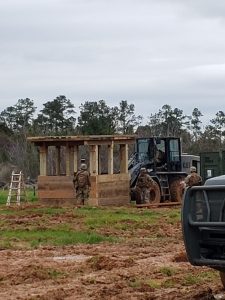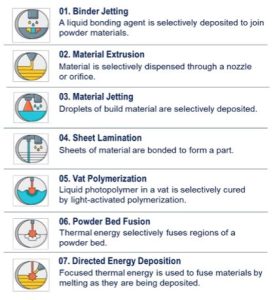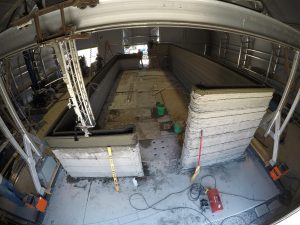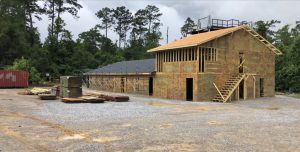7 Additive Construction Potential in U.S. Naval Construction Force Contingency Engineering Applications
Charles "Trey" Sweet, P.E.
ACKNOWLEDGEMENT
I’d like to open by extending my sincerest gratitude to Dr. Mike Case, former Additive Construction (AC) Program Manager for the U.S. Army Engineer Research and Development Center (ERDC). Dr. Case eagerly and generously devoted his time to a one-on-one interview and was a wealth of programmatic knowledge. His perspective and “sea stories” that precede AC emergence helped immensely to understand the past, appreciate the present, and envision the future of the technology.
Barring references to exterior sources, successive AC process insights are attributed to our discussion.
ORIENTATION
BACKGROUND
As a career-minded active duty U.S. Navy Civil Engineer Corps Officer, I have vested interest in any technologies that can improve construction execution performance. AC, the adoption of the three-dimensional (3D) printing concept in building practices, is one technological process development that is becoming increasingly popular in private construction industry applications; reason being that AC employment can effectively reduce construction labor requirements, increase work in place productivity, improve onsite safety, and enable greater material resource sustainability among other benefits. The National Aeronautics and Space Administration (NASA) even views AC technology as a viable means of resolving the foreseeable logistical challenges arising from extraterrestrial colonization ambitions [1].
Focusing on austere environments that are much closer to home, relatively speaking, the military service branches in the U.S. Department of Defense (DoD) all boast their own respective construction organizations that support a multitude of peacetime and wartime missions. However, none of the services have yet to harness the full potential of AC technology with research and development efforts for a functional and reliable system still substantially underway.
PURPOSE & FOCUS
The purpose of this case study was to investigate how AC technology adoption could perhaps benefit the U.S. Naval Construction Force (NCF) in the performance of its contingency engineering operational requirements. To do so, several factors were considered and analyzed such as the capabilities and limitations of modern AC technology, the logistical requirements of 3D printing engineered facilities and structures in contingency construction environments, and current adoption barriers to entry.
WHAT IS THE NCF?
“Construimus, Batuimus”
Translation: “We Build, We Fight”
-Admiral Ben Moreell, Father of the U.S. Navy Seabees

The Navy’s expeditionary construction organization is comprised of over 8,000 combined active duty and reserve Seabees. The Seabee moniker is a play on the letters “CB”, the initials for the original “Construction Battalions” that were formed during World War II [2].
Seabee military construction capabilities are expansive and range from the repair and construction of facilities and infrastructure such as roads, bunkers, airfields, piers, bridges, potable water wells, and expeditionary medical facilities. Known for their adaptability, agility, and scalability, Seabees maintain a continuous deployed presence around the world in direct support of combatant command missions. In peacetime, Seabees provide disaster preparation and recovery services. Additionally, Seabees execute civic action projects and other humanitarian efforts to the benefit of communities in mostly disadvantaged nations.
SEABEE UNITS BY THE NUMBERS
- 2 Naval Construction Groups
- 4 Naval Construction Regiments (2 Active, 2 Reserve)
- 11 Naval Mobile Construction Battalions (6 Active, 5 Reserve)
- 2 Underwater Construction Teams
- 1 Amphibious Construction Battalion
- 2 Construction Battalion Maintenance Units [3]
WHAT IS ADDITIVE CONSTRUCTION?
“I would say, generally, additive construction is any technology that builds up something in layers… The particular flavor (of additive construction) that we (U.S. Army Corps of Engineers) were looking at involved figuring out how to take some form of concrete/cementitious material, extrude it through a nozzle, and build up various shapes.”
-Dr. Mike Case, Former AC Program Manager, U.S. Army ERDC

Of the recognized types of additive manufacturing (AM) processes, AC is typically associated with material extrusion. Extrusion printhead devices methodically stack layers of cementitious material to create desired products. AC systems are most commonly either supported by gantry style frames or radial robotic arms.
Like traditional concrete, AC cementitious mixtures are typically comprised of cement, aggregate, sand, water, and, as applicable, admixtures. Also analogous to traditional concrete, structural reinforcement must be taken into consideration to improve tensile strength and structural ductility. Conventional manually installed steel reinforcement options are common such as rebar, meshes, or cabling. Meanwhile, other more unconventional methods exist such as fiber-embedded mix designs.
To maximize the logistical benefits of the AC process, AC material designs aim for flexibility through reliance on a wide array of indigenously sourced materials, particularly aggregates. Cement, the primary material component that isn’t readily sourced from nature, can still be acquired in local markets virtually anywhere worldwide. Aggregate size and distribution is the most important factor that enables quick yet structurally sound layering. Commercial AC companies typically rely on proprietary fine grain material mix designs that produce structures that are more aesthetically pleasing relative to other more evenly distributed expedient mix designs. However, fine grain material layering is somewhat slower due to lower mechanical strength than offered by larger aggregate between subsequent structural layers.
Similar to other AM practices, AC equipment users may make use of prepopulated libraries to source readily-available design files that precisely direct printing tasks. Of note, gantry style AC systems afford greater shape and size flexibility relative to radial robotic arm units. According to Dr. Case, crews may print a portion of a structure, physically reposition the lightweight gantry system, and print shapes that would otherwise extend beyond the equipment’s fixed range.
The Construction Engineering Research Laboratory in Champaign, Illinois, has successfully three-dimensionally printed a 512 square-foot concrete structure [4].
FINDINGS
MILITARY AC RESEARCH & DEVELOPMENT EFFORTS
The U.S. Army ERDC is spearheading AC research and development from a military perspective. For nearly a decade as of this study, the ERDC AC program has been actively partnering with industry to develop printer systems, functional practices, material mix designs, and material testing methods. The U.S. Army has also organized and executed demonstrations and exercises in order to share findings and lessons learned amongst various federal government stakeholders, particularly interservice leadership. Recently, in March 2024, an “Additive Construction: DoD Path to Adoption” workshop was hosted at Fort Bliss in El Paso, TX, by Army stakeholders alongside numerous other government entities. The goal of the workshop was to promote technical understanding and discuss opportunities, limitations, and milestones for service integration of AC systems [5].

Full-scale 3D printing capability exists; ERDC AC systems are already able to produce various types of facilities (e.g. 16’x32’ windowless four-wall structures referred to as Southwest Asia (SWA) huts) and engineered structures (e.g. pedestrian and vehicular bridges, physical security barricades, culverts, etc.) associated with military applications using a patented extruded cementitious mix design. However, outside of controlled settings, there are limited examples of in-field proof of concepts.
The system nearest to full operational capability, developed under a Cooperative Research and Development Agreement (CRaDA) with industry partner and renowned construction equipment manufacturer, Caterpillar Inc., is a lightweight gantry style unit. The lightweight steel and carbon fiber components enable execution flexibility and portability. The printhead and supporting frame can be set up within about an hour relatively easily by a crew of four to five. Additionally, by partnering with the commercial industry, DoD construction units would stand to have access to entrenched worldwide logistical networks to support repair part resupply needs. Note, the services already leverage this benefit with existing civil engineer support equipment (CESE) inventories (e.g. excavators, bulldozers, etc.). These advantages compound in contingency circumstances, particularly overseas.
A major goal of the ERDC AC program is to maximize indigenous material flexibility for cementitious mixes. The gantry system presently under development, of note, supports both continuous mixing and batch mixing capabilities. Ultimately, mix and structural reinforcement designs necessitate some hands-on engineering in the field. Reinforcement practices that USACE has been experimenting with involve placing a traditional slab, setting anchors, and installing interior conventional rebar as vertical layers are placed. Interestingly, one extrusion method even creates a hollow interior wall that enables placement of rebar without any need to interconnect rebar members.
TECHNICAL STANDARDS
The Unified Facilities Criteria (UFC) is the standard-bearer for all planning, design, and construction activities applying to the armed services. In late-2023, UFC stakeholders partnered with ERDC AC program staff to develop and release its first technical guidance on AC concrete manufacturing [6]. Notwithstanding publication of that guidance, federal AC-specific code and standard development is still a work in progress. The primary issue with comprehensive development and release of detailed specifications has been the reliance on unsubstantiated assumptions about the long-term performance and behavior of 3D printed structures. For frame of reference purposes, the oldest known 3D printed concrete structure in the world, a castle constructed by a homeowner in MN, was completed in 2014 [7].
KEY NEXT STEPS FOR AC ADOPTION
The logistics necessary for packaging and deploying fully functional AC systems is still a work in progress. AC technology has already been proven viable but it won’t be effective in contingency scenarios unless it is tough, reliable, adaptable, quickly deployable, user friendly, and, above all, tested. In relation to the latter stipulation, baseline 3D printing designs need to be programmed that correlate with all expected AC requirements and composed into navigable repositories. Once designs are generated and packaged in a user-friendly format, the services opting to implement AC will need to “train the trainer”. Once trainers are knowledgeable, technical schools and programs will need to be developed in order to effectively train tactical operators to sufficiently operate, repair, and maintain the equipment once deemed fully deployable. Concurrently, operational team requirements will need to be developed and integrated into service specific standard operating procedures to ensure compliance with forthcoming updates to the aforementioned standards and codes.
CONCLUSIONS

First and foremost, some expectations management is warranted. Although USACE has made immense strides in the development of a fully functional AC system, the technology is still in its infancy. To recall, as of this writing, the world’s oldest 3D printed structure is only a decade old [7]. Therefore, considering the life and safety implications of engineered structures, service integration must occur thoughtfully and deliberately. Ultimately, there are still years of work ahead before any military branch can expect to see widespread implementation of AC practices, including the NCF.
With that stated, there are certainly prospective benefits that the NCF could reap in the forthcoming years. Of the host of wartime operational capabilities required of the NCF, Seabees have increasingly concentrated on activities centered on airfields and piers in recent years [8]. I envision that AC could become a particularly effective tool in pier damage repair missions. Airfield construction operations require a predominantly horizontal construction focus which doesn’t lend it to AC applications. Conversely, pier construction operations can involve repairs and improvements to a variety of structures in and around waterfront areas such as piers, wharves, quay walls, and supporting ship-to-shore infrastructure. As such, AC could play an important role in constructing pre-cast segments to support waterfront work. Keeping with wartime contingencies, I can also visualize AC being utilized to fortify and/or supplement physical security features such as defensive perimeters, bunkers, and fighting positions when existing soil and vegetation conditions don’t support construction of earthen berms and/or subsurface structures. Meanwhile, in peacetime scenarios, I see AC being particularly effective in constructing facilities of all classifications during forward-deployed humanitarian missions. In disaster recovery scenarios, the ability to quickly and efficiently print functional load-bearing bridges, as the ERDC-led effort has already demonstrated, could enable the restoration of arterial transportation routes required to satisfy basic human needs.
CLOSING THOUGHTS
The recruitment and retention of skilled construction force labor is growing increasingly difficult in the post-COVID-19 pandemic environment. Ample remote employment opportunities exist that support work-life balances that are perhaps preferable to many. This problem persists especially in the all-volunteer U.S. armed forces where numerous barriers of entry already exist that preclude recruitment of prospective service members. Thus, advocacy for the emergence of AC technology has the potential to mitigate labor gaps by significantly reducing hands-on labor demands in both civilian and military construction applications. Adoption of AC technology may open construction industry doors to individuals that are more technologically adept or otherwise prefer less labor intensive work conditions. Additionally, the relative hands-off nature of extrusion-based 3D printing inherently mitigates many of the risks prevalent in conventional vertical construction activities. This benefit especially translates to expeditionary construction where risk implications are often multiplied by various outside factors. Labor benefits aside, AC may prove effective in scenarios where construction material sources of replenishment become unreliable or inaccessible entirely. With their patented aggregate-based cementitious mix design, USACE has already demonstrated the feasibility of creatively leveraging unconventional sources to satisfy extrusion material requirements. Not only may mix design versatility prove useful when crews are faced with harsh conditions, the practice is much more sustainable and environmentally friendly relative to more exhaustive material conveyances. For all of the aforementioned reasons, I foresee modern AC methods having an increasingly prominent role in construction practices, both civilian and military, in the years ahead.
REFERENCES
[1] L. Mohon. “NASA’s 3D-Printed Habitat Challenge Winners to Discuss Automation and 3D-Printing in Public Panel.” NASA. Accessed: May 27, 2024. [Online]. Available: https://www.nasa.gov/news-release/nasas-3d-printed-habitat-challenge-winners-to-discuss-automation-and-3d-printing-in-public-panel/
[2] “History of the Seabees.” Naval History and Heritage Command. Accessed: May 26, 2024. [Online]. Available: https://www.history.navy.mil/research/library/online-reading-room/title-list-alphabetically/s/seabee-history0/seabee-history.html
[3] “Naval Construction Force.” Commander, Navy Expeditionary Combat Command. Accessed: May 26, 2024. [Online]. Available: https://www.necc.usff.navy.mil/Press-Room/Fact-Sheets/Article/2416185/naval-construction-force/
[4] U.S. Army Engineer Research and Development Center. ACES: 3-D Printing expeditionary structures. (Aug. 25, 2017). Accessed: Apr. 25, 2024. [Online Video]. Available: http://www.youtube.com/watch?v=IJjNsCVHc34
[5] M. Molitch-Hou. “US Army Corps of Engineers’ Megan Kreiger on the State of Construction 3D Printing.” 3DPrint.com. Accessed: Apr. 24, 2024. [Online]. Available: https://3dprint.com/308822/us-army-corps-of-engineersmegan-kreiger-on-the-state-of-construction-3d-printing/
[6] Unified Facilities Criteria (UFC) Structural Engineering, UFC 3-301-01 2-7.2 Section 1903.5, Change 1, Oct. 2023. [Online]. Available: https://wbdg.org/FFC/DOD/UFC/ufc_3_301_01_2023_c1.pdf
[7] K. Smith. “Minnesota Man Builds Castle with 3-D Concrete Printer.” Star Tribune. Accessed: Apr 25, 2024. [Online]. Available: https://www.startribune.com/minnesota-man-builds-castle-with-3-d-concrete-printer/273410261/
[8] Required Operational Capabilities and Project Operational Environment for the Naval Construction Force, OPNAV Instruction 3501.115G, Chief of Naval Operations, Washington, DC, USA, Feb. 2023. [Online]. Available: https://www.secnav.navy.mil/doni/Directives/03000%20Naval%20Operations% 20and%20Readiness/03-500%20Training%20and%20Readiness%20Services/3501.115G.pdf
Media Attributions
- Seabee Guard Shack Project © Charles "Trey" Sweet
- Additive Manufacturing Processes © ASTM International
- Partial 3D Printed Structure © U.S. Army ERDC
- Seabee Breacher Trainer Project © Charles "Trey" Sweet

